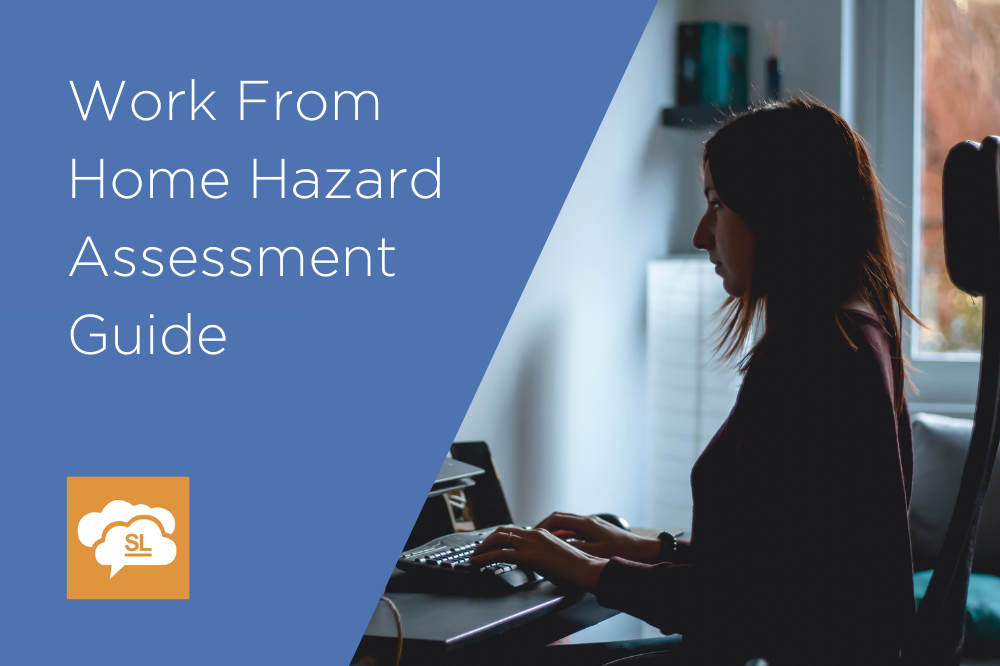Work From Home Hazard Assessment Guide
When COVID-19 turned our world upside down last spring, the global labor market responded, sending many of its workers to perform their jobs remotely and at home. According to Stats Canada, nearly 40% of Canadians were working from home in the last week of March and those numbers have undoubtedly increased over the summer. And according to the Stanford Institute for Economic Policy Research, as of June, 42% of the U.S. labor force is working full-time from home. It is undeniable that working from home has become the new normal and with that, we need to look at how to protect workers in their homes which include safety hazards like any other workplace.
The first step to making sure your workers are safe while doing their jobs from home, is to identify all of the potential hazards that put them at risk. Below, download our simple Home Hazard Assessment Checklist that will help you to effectively identify all the hazards in your home workspace. This useful guide will provide a step-by-step outline to follow when conducting a thorough at-home hazard assessment.
View our Home Hazard Assessment Checklist
To work safely from home, you must first ensure that identify, document and then mitigate any hazards that could jeopardize your well-being. You should not simply assume that you are safe just because you are at home. Here are the risks you need to consider:
Biological home hazards
Biological hazards in our home are invisible hazards in your home, such as pathogen microorganisms, bacteria, and these days, viruses like COVID-19. When looking at your home work environment, look for potential hazards like gas leaks, mold, or areas with frequent human contact. Additionally, regular exposure to common dust particles can increase your chances of developing chronic respiratory and heart health issues.
Chemical home hazards
It is an unfortunate fact, but your home is likely to contain a range of chemicals that cause a number of diseases and chronic conditions. Depending on the age and condition of your home, you may be exposed to harmful toxins in cleaning chemicals, asbestos, exposed ammonia and bleach, and/or drain cleaners.
Physical home hazards
Like biological and chemical hazards, physical hazards when working from home can depend on how old your home is and what kind of condition it’s in. Hazards could include collapsing work stations and chairs, as well as issues with structure itself. Shockingly, another hazard could be violence from home invasions and theft with offenders coming to your home during work hours when people are usually out.
Electrical home hazards
If you have an older home, you may have outdated and incorrect wiring or three-pronged grounded outlets, creating more potential for electrical hazards and fires. On top of that, take care of any broken or frayed electrical cords, which can cause fires and make sure you don’t overload your home’s circuits by plugging in too many cords into the same outlet.
Fall home hazards
While it’s something we don’t take seriously all of the time, slips, trips and falls are common injury for those working at home. To address this, you need to clear routes and use areas of any obstructions like general clutter, kids toys or loose rugs. You also need good lighting so, obviously, you can see where you’re going.
Environmental home hazards
A relatively underestimated category, environmental hazards can make an impact on our health, particularly on mental health. Be mindful of issues like insufficient lighting and excessive noise which, apart from making work the itself difficult, can affect your emotional well-being. Try to situate your workspace near a window for functional, natural light. If there’s excessive or annoying noise, look at noise-canceling earphones for noise and there’s no window, consider halogen desk lamps for bright office lighting; LED desk lamps are a great option as well.
Ergonomic home hazards
You’re going to spend many hours in your home office or workspace, so you need to make sure your desk is safe and comfortable - or you could end up with musculoskeletal disorders. Ergonomic hazards are everywhere at home, the most common adjustments to make are with your chair and table. Ergonomic chairs are height adjustable, have a 360-degree swivel base, have lumbar support, and can also adjust the backrest, armrest, and seat depth - a stand-up desk is a great option as well. Additionally, make sure you get up to walk or exercise at least every few hours.
Next steps
Once you have identified which hazards are present, now it’s time to take steps to either eliminate or mitigate the risks. Following this free Home Hazard Assessment checklist will help you to effectively identify and eliminate hazards in your home workspace and then work on mitigating them.
Conducting a thorough work-from-home hazard assessment is crucial for ensuring safety and productivity. Use our Lone Worker Safety Solution App for reliable monitoring, and explore our pricing options. Visit our FAQ page to address your concerns, and learn about the benefits of our solutions. Equip your team with the right tools, including advanced lone worker safety devices.

